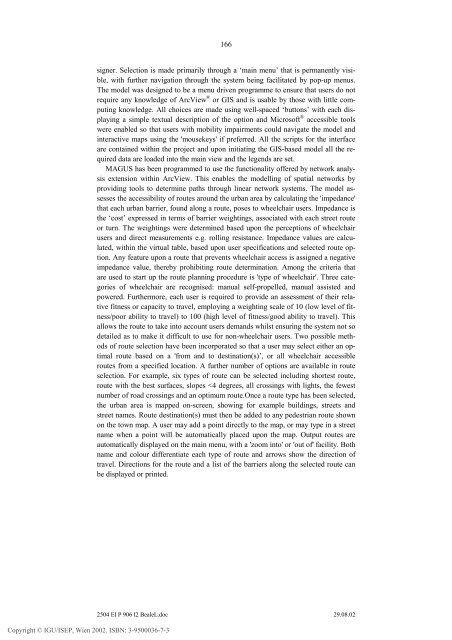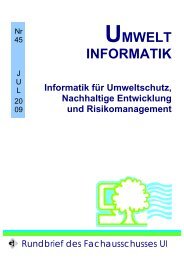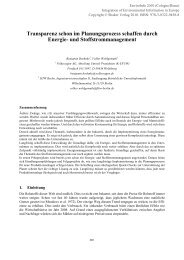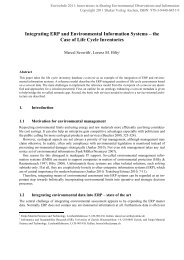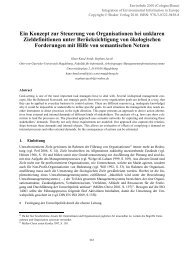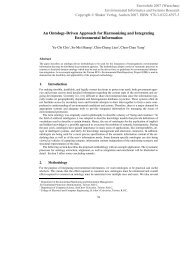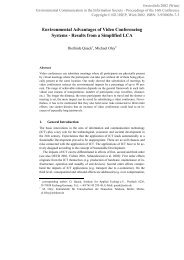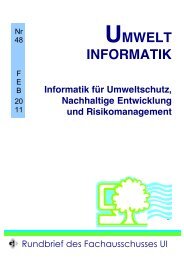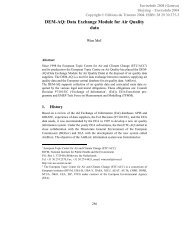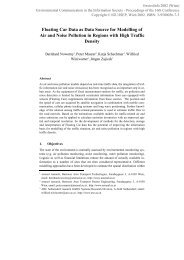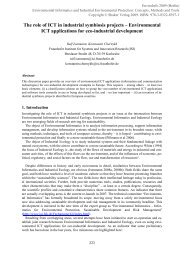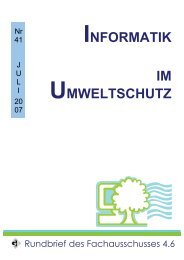A GIS-based Route Mapping Tool for Disabled Access in Urban ...
A GIS-based Route Mapping Tool for Disabled Access in Urban ...
A GIS-based Route Mapping Tool for Disabled Access in Urban ...
Create successful ePaper yourself
Turn your PDF publications into a flip-book with our unique Google optimized e-Paper software.
166signer. Selection is made primarily through a ‘ma<strong>in</strong> menu’ that is permanently visible,with further navigation through the system be<strong>in</strong>g facilitated by pop-up menus.The model was designed to be a menu driven programme to ensure that users do notrequire any knowledge of ArcView ® or <strong>GIS</strong> and is usable by those with little comput<strong>in</strong>gknowledge. All choices are made us<strong>in</strong>g well-spaced ‘buttons’ with each display<strong>in</strong>ga simple textual description of the option and Microsoft ® accessible toolswere enabled so that users with mobility impairments could navigate the model and<strong>in</strong>teractive maps us<strong>in</strong>g the 'mousekeys' if preferred. All the scripts <strong>for</strong> the <strong>in</strong>terfaceare conta<strong>in</strong>ed with<strong>in</strong> the project and upon <strong>in</strong>itiat<strong>in</strong>g the <strong>GIS</strong>-<strong>based</strong> model all the requireddata are loaded <strong>in</strong>to the ma<strong>in</strong> view and the legends are set.MAGUS has been programmed to use the functionality offered by network analysisextension with<strong>in</strong> ArcView. This enables the modell<strong>in</strong>g of spatial networks byprovid<strong>in</strong>g tools to determ<strong>in</strong>e paths through l<strong>in</strong>ear network systems. The model assessesthe accessibility of routes around the urban area by calculat<strong>in</strong>g the 'impedance'that each urban barrier, found along a route, poses to wheelchair users. Impedance isthe ‘cost’ expressed <strong>in</strong> terms of barrier weight<strong>in</strong>gs, associated with each street routeor turn. The weight<strong>in</strong>gs were determ<strong>in</strong>ed <strong>based</strong> upon the perceptions of wheelchairusers and direct measurements e.g. roll<strong>in</strong>g resistance. Impedance values are calculated,with<strong>in</strong> the virtual table, <strong>based</strong> upon user specifications and selected route option.Any feature upon a route that prevents wheelchair access is assigned a negativeimpedance value, thereby prohibit<strong>in</strong>g route determ<strong>in</strong>ation. Among the criteria thatare used to start up the route plann<strong>in</strong>g procedure is 'type of wheelchair'. Three categoriesof wheelchair are recognised: manual self-propelled, manual assisted andpowered. Furthermore, each user is required to provide an assessment of their relativefitness or capacity to travel, employ<strong>in</strong>g a weight<strong>in</strong>g scale of 10 (low level of fitness/poorability to travel) to 100 (high level of fitness/good ability to travel). Thisallows the route to take <strong>in</strong>to account users demands whilst ensur<strong>in</strong>g the system not sodetailed as to make it difficult to use <strong>for</strong> non-wheelchair users. Two possible methodsof route selection have been <strong>in</strong>corporated so that a user may select either an optimalroute <strong>based</strong> on a 'from and to dest<strong>in</strong>ation(s)’, or all wheelchair accessibleroutes from a specified location. A further number of options are available <strong>in</strong> routeselection. For example, six types of route can be selected <strong>in</strong>clud<strong>in</strong>g shortest route,route with the best surfaces, slopes


